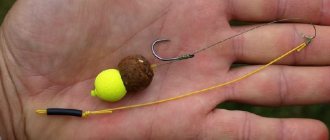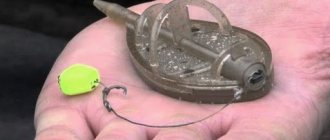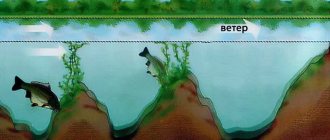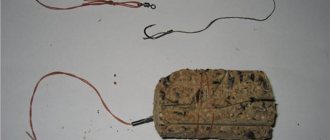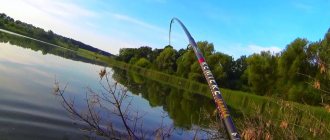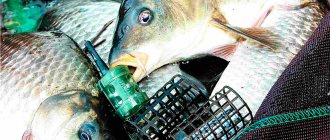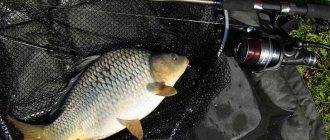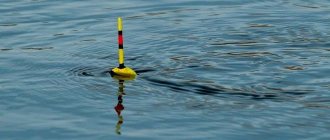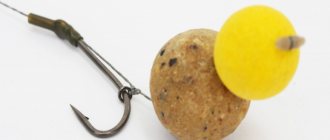10.26.2016 admin
When considering carp fishing with a float rod on commercial reservoirs, you cannot ignore match gear. It often has advantages over traditional fishing with a rod with rings (Bologna type) and even a plug. This advantage lies in the fishing distance. If the first two methods are limited by the length of the rod, then long-cast carp fishing is successful at distances of up to 40 m or more.
Although, in my opinion, a spinning reel is inferior to an inertial one when fishing, it is still a huge plus in the fight against strong and fairly large fish.
Often, to catch pond carp, a long casting distance is not needed: the working point is selected either at the nearest edge or at a distance comfortable for fishing and feeding. And only in rare cases, for example, a very long sandbank or in cool water the fish have already moved to wintering pits - to a distant, deep edge, long casting shows itself in all its glory, allowing you to “get” the fish from a long distance.
So I, once again coming to my favorite ponds in the near Moscow region to catch “sports” carp and knowing that there were no obvious differences in this reservoir, simply chose a comfortable casting distance - about 20 m.
At this distance you can feed very accurately by hand; a slingshot with medium-hard rubber allows you to accurately feed grains, and most importantly, you can use very light (by the standards of long-casting!) and quite sensitive equipment.
For feeding I use 2 kg of tested and proven carp bait, I add a can of corn and a little aroma to it - to attract fish faster. Everything else is already contained in the food.
Pay attention to the consistency of the finished bait: when casting over a long distance, the balls should not fall apart in the air, and at the same time, the food should not be over-wetted - otherwise it will take too long to disintegrate in the water. Therefore, the groundbait must be soaked in several stages with mandatory infusion time.
To accurately cast bait over a long distance, all balls must be the same size. I leave a small part of the food (about 10-15%) for supplementary feeding - I will use it after an hour and a half of fishing, when a school of fish has already arrived at the feeding point and has mostly eaten the starting portion of food. During the fishing process, I will feed it with corn grains from a slingshot.
The best bait for today - after trying several options - is one grain of corn and one maggot. With a couple of grains we had to wait longer for a bite, and only maggots were sometimes intercepted by roaches and small carp.
Features of match gear for carp
While the bait is infusing, I’m working on the gear. A couple of rods are already equipped with reels and fishing line at home; all that remains is to hang the float required for fishing conditions on the pond and load it, which takes a few minutes.
Choosing a float is an important point: you need to take into account the fishing range, weather conditions (wind strength and direction), the depth at the fishing site, and it is always worth remembering that a lighter float will be more sensitive.
I mark the fishing range on the fishing line with a marker. You cannot fish for carp with a rigid fishing line (in a clip): with a sharp jerk at the beginning of fishing, and this is not uncommon, the fish has every chance of breaking the leash or getting off. Even if very small carp are caught, a trophy cannot be ruled out. From time to time the label needs to be updated.
Briscola floats (701, 702 and 803) of the “multicolor” type are ideal for long-casting carp fishing - they perfectly show bites on sinks and rises, and due to the massive loading of the body they have good flight qualities.
A pair of floats 2+4 g and 2+6 g (2 g is loading the float, the rest is loading on the line) took the working position on the line. Fastening the floats is the simplest - the fishing line is threaded through a carabiner twice, and the float is secured with a clasp. This allows you to quickly replace it if fishing conditions change or break down. Also, the carabiner and clasp prevent the float from hitting the weights.
Almost all the weights are located near the float and at the same time fix it on the fishing line; Closer to the leash there is a sub-hook weighing about 0.3 g for faster immersion of the equipment.
The rig ends with a micro-swivel; it prevents the fishing line from twisting when attaching a pair of maggots, and at the same time serves as a sub-swivel. The depth on both rigs is set so that the hook slightly touches the bottom - this is the best solution for getting bites. In case of strong lateral current, the lower weight will have to be placed on the bottom (increase the depth by the length of the leash), which will worsen the sensitivity of the tackle.
A short break for a couple of sandwiches and tea, a few idle casts, catching a roach, and now the first carp bends the rod.
Classification of match rods
Depending on the fishing conditions, match rods can be classified into the following classes:
– for fishing with light sticks and wagglers (waggler float for match fishing); – carp matches; – a match for long-distance fishing.
Within each class, gear can be distinguished based on its length, construction and tests.
Classic match for fishing with light sticks and wagglers
Designed for catching medium and small fish at distances of up to 25 - 30 m.
Fishing rods of this class are available in lengths from 3.5 to 4.5 m. The classic length is 3.9 m.
The tuning can be “soft” or “medium-hard”.
Carp fishing matches
A match rod for carp fishing should be as durable as possible and be capable of casting light sticks. The latter is necessary when fishing for carp feeding in shallow waters.
Carp rods are characterized by a thick-walled blank, which is due to the increase in the strength characteristics of such a rod.
Match rods for carp can range in action from “soft” to “medium”. These parameters allow you to cast long distances and successfully fight strong fish after hooking.
Match rod for long distances
The match for fishing at long distances is designed for long casting, about 40-50 m or more. The length of the form is usually 4.5 m. Some manufacturers offer forms up to 4.8 m long.
Forward Long Distance Match from Surf Master. The Forward Long Distance Match rod has gained wide popularity among long-distance anglers, allowing long-distance and accurate casts.
Rod for match carp fishing
A few words about the rod: for carp match fishing, you should use special “match rods”; they differ from ordinary ones in their increased power, short length (usually 3.6 m) and soft action. The last parameter is extremely important: the “noodle” type action allows you to cast light equipment far and accurately and perfectly “ties” the fish when playing.
The carp resists to the last and even near the shore can give out a series of somersaults; A rigid rod at a short distance is not able to fend off the jerks of the fish, which means you have to risk either the tackle breaking or the rod breaking.
Even if the fish rushes “under your feet,” a soft rod allows you to control the situation and is not afraid of critical bending. The same rod works great for any fishing on still waters when light equipment is required, including when fishing for trout, crucian carp or tench.
Towards the end of the fishing, when the carp bites became less frequent, and there was no point in feeding more - it was necessary to stop fishing, a tench was caught. This is an infrequent trophy, and therefore doubly pleasant; this can quite be the end of today’s fishing.
A landing net with a large diameter and with “foam” floats on the rim has positive buoyancy - during fishing, it lies on the water without the participation of the angler and waits for its moment.
Catching "sports" carp with a match rod is a great way to practice long-casting and get a boost of energy for the coming week.
Match tackle for carp
In the Moscow region there are many pay ponds where carp are often caught when fishing for crucian carp with a fly rod with a blind rig. This method is distinguished by its mobility, the ability to use attachments that are weakly held on the hook, and most importantly, when casting there are extremely rarely overlaps between the leash and the main fishing line. But it also has disadvantages: the fishing range from the shore is limited, as a rule, to a distance of 10-15 m, the use of thin fishing lines is excluded, the fishing process takes place above the baited area. Match tackle for carp fishing does not have all these shortcomings.
For the first time, the cultivation of this fish began in China. Then breeders from many countries created various breeds of carp: naked, mirror, scaly. Carp, as a rule, differs from carp, its wild counterpart, by its greater body height and humpback. Thanks to their omnivorous nature, carp grow quickly, reaching a weight of 400-600 g in two years of life. In general, carp grow up to a meter in length with a considerable weight - there are cases of catching carp weighing 20-30 kg. It feeds on various aquatic organisms and larvae, which it finds in silt, among algae and snags, as well as all kinds of plant foods. Adult carp sometimes eat small fish. In winter, carp are inactive, but in some reservoirs (with a hard bottom) they are sometimes caught from the ice.
SEARCHING FOR CARP SITES In small ponds, carp sites can be found in places where the bottom goes steeply into the depths, among gaps of aquatic vegetation. In lakes and reservoirs, it also stays on the border of deep-water areas, near underwater elevations overgrown with grass, going out to feed in shallower areas. River carp stick to quiet, deep holes, and at dawn they like to visit bays and creeks to dig in the bottom silt in search of tasty larvae and shells. This can be easily determined by the chains of bubbles coming from the bottom.
Large carp especially love to visit colonies of the zebra mussel. Dreissena is not only a high-calorie food for carp. It is precisely where its colonies are located that there is always enough oxygen and there is excellent water circulation. A rough bottom with varied topography also attracts carp. It is no coincidence that in the West, some owners of private carp ponds create many artificial snags, which over time become favorite habitats for large carp. In spring, carp begin to be active after the water warms up to about +10. As the water gets colder, the spring carp bite worsens sharply. In general, it must be said that he feels most comfortable at a water temperature in the range from +7 to +18. At the beginning of summer, during the daylight hours, several periods can be distinguished during which carp are most active in search of food. This is the early morning hours - just after sunrise. Noon and time after sunset - before dark. The rest of the day, the carp either stands at half-water or walks in its upper layers, throwing itself upright above the surface and noisily falling back into the water. Towards the end of summer, on warm cloudy days with little wind, the bite sometimes continues from dawn to dusk. Large individuals are also found at night.
In the middle zone, carp fishing in ponds in open water begins in May, when the water warms up well enough, and ends in September-October, when it gets colder. In flowing waters, carp remain active longer.
IF YOU FAIL TO FEED, YOU WILL NOT Catch Experience shows that you can successfully fish for carp only, as a rule, in well-fed places. And during the fishing process, the bite is activated if you throw in portions of bait from time to time: boilies, granulated feed based on cakes, steamed cake, peas, boiled crumpled potatoes (new), bran mixed with ground toasted sunflower seeds. You can, of course, also use fresh feed mixtures intended for carp. Anise oil (very dosed), vanillin, crushed hemp seed, and special carp attractants are used as aromatic additives. Carp has an excellent sense of smell, and if you guessed right with the bouquet of aromas, it will certainly be suitable for bait.
CHOOSING A RODS A well-chosen match rod with a certain margin of safety is the first step on the path to mastery. Optimal: length 3.96 m, form has 12 rings plus a tulip. Build quickly. All match rods can be legitimately divided into some kind of classes based on the weight of the equipment being cast (float, set of sinkers, bait). Light class - up to 8-10 g, medium - up to 20-25 and heavy - over 25 g. Some models of match rods are designed to cast equipment up to 80 g. With such a rod, you can make casts at a distance of up to 100 m without any problems. The casting distance is influenced by the following factors: rod structure, uniform winding of fishing line on the reel spool, shape and weight of the float, wind direction (side, head, from the shore). When choosing a fishing rod, be sure to pay attention to the number and location of the rings on the blank. They must be of a suitable diameter (the first from the coil is at least 8 mm inside) and installed on high legs. Otherwise, you will constantly be dealing with wet line sticking to the blank, which naturally reduces your casting distance. When you cast forcefully over your head and the main line overlaps the tulip or ring of the rod, you can simply “shoot” the rig with the float dear to your heart. Therefore, before each cast, make sure that there is no overlap. I consider the most versatile rod to be up to 4 m long. With longer ones, problems arise when fishing from a bank overgrown with trees and bushes, which, you see, happens quite often.
A reel for match carp fishing should be selected after purchasing a fishing rod. First of all, both of these elements of gear must be well balanced. The less the rod and reel weigh, the better. The main difference between a match reel and a spinning reel is the slightly larger diameter of the spool and it is less deep. The fact is that when casting fairly light equipment (2-5 g), and even with a headwind or side wind, delivering the bait to the feeding point will be problematic. You can, of course, make the equipment heavier, but this does not always work with cautious carp - the fish becomes extremely picky. A matcher should be considered balanced if, after installing the reel, the center of gravity is located between the upper part of the handle and the first throughput ring.
A LOT DEPENDS ON THE REEL Quite often, novice carp fishermen have to deal with questions about how much weight the reel should be, how many bearings it should have, etc. When choosing a reel, a lot depends on what size carp you are going to fish for. Runts up to 500 g are one thing, and seasoned trophies, the fight against which is truly an exciting event, is quite another. There are several basic rules that must be followed when choosing a reel for carp fishing.
You purchased a reel with a front brake, forgetting that after hooking the carp makes a powerful throw. In this case, using the rear clutch will, of course, be much more convenient. Experienced carp anglers, by adjusting the clutch during the fishing process, can easily reel in even such strong fish as carp. 2. Often carp have to be caught at a distance of 50 meters or more from the shore. In such a situation, a high-speed reel will make your actions quicker. With its help, you will quickly reel in the equipment, which will have a positive effect on your fishing results. When fishing for large carp, it is not the number of bearings that is important, but in which units they are located. This is primarily the rotor, drive gear supports, and line roller.
SOMETHING ABOUT THE EQUIPMENT The main requirement for carp equipment is its reliability. It is necessary to make it a rule to carefully check the knots before each fishing trip. It is better to abandon swivels, carabiners and other attributes that not only scare away cautious carp, but also significantly weaken the strength of the tackle. In this case, the leash is attached to the main line using the “loop-to-loop” method. Don’t forget that the more knots there are, the less strength the gear has. In order not to waste time installing equipment on the shore of a reservoir, several equipment is made at home, completely ready for connection to the main fishing line. 2-3 plastic bags with equipment is not the biggest load when going fishing. But all that remains is to measure the depth and connect the equipment to the main fishing line.
Depending on the weight of the equipment, a high-quality fishing line with a diameter of 0.16-0.20 mm is used as the main one. A thicker line significantly reduces the casting distance, and it “sails” more strongly under the influence of current or wind. In any case, the leash should be weaker in strength than the main line. When fishing for carp weighing over five kilograms, you need appropriate gear. And finally about the floats. In match fishing, you can use both regular floats and self-loaded ones. In recent years, torpedo-shaped floats have been used when fishing for carp. Why? Firstly, they allow you to make long casts, and secondly, their load is easily adjusted using removable washers. But most importantly, do not be lazy at home, taking into account the nozzle, adjust the float surround so that 2 cm of the antenna is above the surface of the water.
Vladimir Kazantsev June 19, 2012 at 00:00
Match equipment for carp fishing
Match equipment. The idea of catching carp with a match fishing rod has been in the air for a long time: it was necessary to dispel the persistent belief of many anglers that sports gear is only good for catching small fish. This opinion was formed, apparently, in the era of using fly fishing rods with blind equipment, the capabilities of which are really limited.
And later it was automatically transferred to all gear used in sports. However, the advent of plug rods with a built-in shock absorber solved this problem: now one piece of gear combines the lightness and sensitivity of a float rod and the huge margin of safety that comes from a properly selected and tuned shock absorber.
After a short search for a suitable reservoir, the following picture emerged. Most fish farms operate on the principle: money in the morning, chairs in the evening, that is, they release one-year-old carp into the reservoir, and sometimes even fingerlings - weighing 100-200 g, which fishermen are forced to catch, and even pay a lot of money for this dubious pleasure.
In the fall, the pond is drained and the remaining fish are sold. The next year the whole cycle repeats. One of the few farms aimed specifically at the interests of fishermen is the Russian Carp Club, located at the Bear Lakes base. The club management kindly provided us with the opportunity to go fishing and take photographs, for which we are very grateful to them.
Since carp, especially large ones, is a serious and thorough fish, then the approach to it should be appropriate. We had been at the reservoir since evening. It was necessary to lay out all the gear ahead of time, prepare the bait and feed the fishing point, and in the morning, fully armed, wait for the fish to approach.
According to a club employee who helped set up tents rented here.
The reservoir is home to carp, brought from the Astrakhan region, and pond carp, weighing from 1.5 to 17 kg, in addition, there is grass carp and fish familiar to the middle zone: crucian carp, roach and perch. We were primarily interested in large carp. Therefore, the match equipment for carp fishing was compiled accordingly.
The rod - my favorite Team Milo 899 - is already normally designed for a rubber shock absorber up to No. 16 (2.1 mm in diameter), however, I still decided to play it safe and equipped the carp whales with such rubber so that they have a large margin of safety. The main line is 0.19 mm, the leash is 0.17 mm, the hook is No. 10-12.
The float is the lightest, with a carrying capacity of 0.3-0.17 g, carp, with a reinforced keel and ring, as well as a slightly thicker antenna. Schemes for loading gear are the simplest - at one or two points. Such tackle can withstand fishing for 5 kilograms, and with a successful combination of circumstances, much larger carp.
Match equipment for carp fishing
Another important component of success is bait. Like any large fish, carp can only be attracted to a fishing spot with a small amount of food by chance, so taking into account the duration of fishing (almost a day), the total amount of bait was just over 10 kg (dry). The basis of the bait was 2 kg of coarsely ground Carpes et gros poissons from Sensas.
Since the bait needed to be “long-lasting” - for the whole night, it had to be made more sticky, for which a 2-kg bag of Canal bait from Ballabeni was used. However, 4 kg of bait for the entire fishing trip is clearly not enough, so as an additional component that increases the total volume, inexpensive domestic bait was used - “Unikorm - Carp” in an amount of 4 kg.
It is known that the warmer the water, the more flavorings there should be in the bait, and in this case, a bag of Carpixa from Sensas came in handy. The composition was crowned with several kg of granulated fish feed and one and a half jars of canned corn. The carp in the reservoirs near Moscow are accustomed to these components and are clearly not indifferent.
Carp bait is infused for quite a long time - at least one to two hours. After this, it is mixed again, if necessary, additionally moistened and sifted through a coarse sieve. You can add a small amount of large bloodworms, maggots or cut worms to the bait.
But it should be taken into account that bloodworms can attract small fish, and maggot very strongly and quickly destroys bait balls in the water, so it is better to use it for supplementary feeding from a cup or using a slingshot. I used about two thirds of the bait right away - for feeding in the evening, and left one third for the morning.
Since I had to feed at dusk, I set up a float in which the replaceable antenna was replaced with a firefly, and thanks to this “beacon” all the balls of bait fell exactly on target. In the morning, still dark, I decided to check what was happening at the feeding point, but The antenna of the float - the firefly froze completely motionless - there were no bites.
But as soon as dawn broke and the sky in the east brightened, the bites began, but instead of the expected carp, crucian carp began to be caught. Having caught several fish, I fed them again by throwing several balls to the float, and took a break from fishing so that the scared fish would again gather at the baited place. But this didn’t help either - crucian carp again. You will learn how to catch pike with live bait using float tackle here.
The carps, as if mocking me, started a stormy fuss far from the shore. Apparently, you will have to use tackle for long casting. I quickly assemble and equip a couple of fishing rods; measuring the depth shows a monotonous increase in it and a small drop about 35 meters from the shore - this is where you should fish.
Match rig with a Waggler type float for carp fishing
But what to do with bait? Even with the added Canal from Ballabini, it is still too loose for long-distance casting. And then I remember that in the car there should be a couple of bags of Marcel Van den Eynde bait for roach, saved for the next competition, one of which (Turbo) is just what is needed for this situation.
I quickly stir everything, add another packet of “Unikorm - Carp” and use a slingshot to feed the point. And now the long-awaited carp bite - hooking, yes! A few seconds of struggle, and... an unfortunate collapse. Athletes say that if you lose fish twice, change the hook. For me, just one go is enough - I use a Suehito 303 hook, series No. 10.
Match equipment for carp fishing in working position
The fish won't get away with this! Cast again, but there are no bites - the fish that came down scared away the relatives. Out of boredom, I start trying different baits: corn, maggot, maggot, corn with bloodworms - it gets a bite. I hook him - he’s sitting! For several seconds there is a tug-of-war between “who will win” in one place, then the carp gets tired of it, and it flies headlong in a large arc to the right - into the saving bushes under the shore.
You can’t let him go there, and with some effort I turn him around a few meters from the shore - the gear, however, allowed me to use force, which I took advantage of. Further fishing ended a few minutes later with photographing with a handsome carp. The next bite again had to wait. I hook the hook, and the carp immediately flies to the shore, but not in an arc, but directly!
I feverishly reel in the line, but the carp moves faster, and he wins this competition. The battered float torn from the bushes became a small consolation. This is what the “catch and release” principle means, which is mandatory on this reservoir: carp quickly learned how to deal with fishermen.
The next bite did not take me by surprise, I won the speed competition, and a few minutes later the mirror carp appeared for another photo as a souvenir. However, that was all; in the afternoon the bite stopped. There were, however, a few more small perch bites on bloodworms.
A few words about the equipment used for long-distance casting. The main line is sinking, with a diameter of 0.16 mm, the shock leader is about 10 m long, with a diameter of 0.18 mm. This length is necessary because the shock leader takes on the load not only at the moment of casting the equipment, but also in the final stage of landing large fish. Leash - 0.16 mm, hook - No. 10.
The float is Milo 16 g, with a load of approximately 1.5 g and a hollow tube antenna, which allows you to record the most careful bites. By the way, during fishing I had to change antennas of different colors three times: in the morning, when the sun was low and shining directly into my eyes, the yellow one was better visible, then against the light background of the reflected sky - black, and when the sun moved to the side - red.
The use of a heavy float (16 + 1.5 g) turned out to be quite justified, firstly, because of the rather thick line, and secondly, because of the need for long casting - it was necessary to move the fishing point significantly in order to sink the line sufficiently and the ability to disturb the fish less with splashes of the float at shallow depths.
As for some loss of sensitivity, it was compensated by more decisive fish bites far from the shore. However, I have repeatedly seen how foreign fishermen in such conditions use floats of 20-22 g, and clearly not to the detriment of fishing.
So, this fishing and, indeed, all the experience of sport fishing, both foreign and domestic, show that the use of modern sports gear for catching large fish is not only justified, but also very effective, especially in “difficult” reservoirs. The pleasure of catching a large fish with elegant tackle is not at all comparable to the kind of fishing that is usually practiced.
Author Andrey Kashtanov
